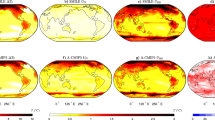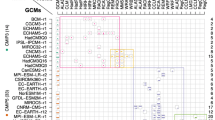Abstract
Characterization of climate uncertainty at regional scales over near-term planning horizons (0–30 years) is crucial for climate adaptation. Climate internal variability (CIV) dominates climate uncertainty over decadal prediction horizons at stakeholders’ scales (regional to local). In the literature, CIV has been characterized indirectly using projections of climate change from multi-model ensembles (MME) instead of directly using projections from multiple initial condition ensembles (MICE), primarily because adequate number of initial condition (IC) runs were not available for any climate model. Nevertheless, the recent availability of significant number of IC runs from one climate model allows for the first time to characterize CIV directly from climate model projections and perform a sensitivity analysis to study the dominance of CIV compared to model response variability (MRV). Here, we measure relative agreement (a dimensionless number with values ranging between 0 and 1, inclusive; a high value indicates less variability and vice versa) among MME and MICE and find that CIV is lower than MRV for all projection time horizons and spatial resolutions for precipitation and temperature. However, CIV exhibits greater dominance over MRV for seasonal and annual mean precipitation at higher latitudes where signals of climate change are expected to emerge sooner. Furthermore, precipitation exhibits large uncertainties and a rapid decline in relative agreement from global to continental, regional, or local scales for MICE compared to MME. The fractional contribution of uncertainty due to CIV is invariant for precipitation and decreases for temperature as lead time progresses towards the end of the century.






Similar content being viewed by others
References
Alexandridis A, Zapranis AD (2012) Weather derivatives: modeling and pricing weather-related risk. Springer Science & Business Media, New York
Barsugli J, Anderson C, Smith J, Voegl J (2009) Options for improving climate modeling to assist water utility planning for climate change. Technical report. https://www.researchgate.net/profile/Jason_Vogel3/publication/252503020_Options_for_Improving_Climate_Modeling_to_Assist_Water_Utility_Planning_for_Climate_Change/links/0deec52f1332679710000000/Improving-Climate-Modeling-to-Assist-Water-Utility-Planning-for-Climate-Change.pdf
Bauer P, Thorpe A, Brunet G (2015) The quiet revolution of numerical weather prediction. Nature 525:47–55
Daron JD, Stainforth DA (2013) On predicting climate under climate change. Environ Res Lett 8:34021
Deser C, Knutti R, Solomon S, Phillips AS (2012a) Communication of the role of natural variability in future North American climate. Nat Clim Change 2:775–779
Deser C, Phillips A, Bourdette V, Teng H (2012b) Uncertainty in climate change projections: the role of internal variability. Clim Dyn 38:527–546
Deser C, Phillips AS, Alexander MA, Smoliak BV (2014) Projecting North American climate over the next 50 years: uncertainty due to internal variability. J Clim 27:2271–2296
Deser C, Terray L, Phillips AS (2016) Forced and internal components of winter air temperature trends over North America during the past 50 years: mechanisms and implications. J Clim 29:2237–2258
Fischer EM, Beyerle U, Knutti R (2013) Robust spatially aggregated projections of climate extremes. Nat Clim Change 3:1033–1038
Ganguly AR, Kodra EA, Agrawal A et al (2014) Toward enhanced understanding and projections of climate extremes using physics-guided data mining techniques. Nonlinear Process Geophys 21:777–795
Ganguly AR, Kumar D, Ganguli P et al (2015) Climate adaptation informatics: water stress on power production. Comput Sci Eng 17:53–60
Hall JW, Grey D, Garrick D et al (2014) Coping with the curse of freshwater variability. Science 346:429–430
Hawkins E, Sutton R (2009) The potential to narrow uncertainty in regional climate predictions. Bull Am Meteorol Soc 90:1095–1107
Hawkins E, Sutton R (2011) The potential to narrow uncertainty in projections of regional precipitation change. Clim Dyn 37:407–418
Hawkins E, Anderson B, Diffenbaugh N et al (2014) Uncertainties in the timing of unprecedented climates. Nature 511:E3–E5
Hawkins E, Smith RS, Gregory JM, Stainforth DA (2016) Irreducible uncertainty in near-term climate projections. Clim Dyn 46:3807–3819. doi:10.1007/s00382-015-2806-8
Jun M, Knutti R, Nychka DW (2008a) Spatial analysis to quantify numerical model bias and dependence: how many climate models are there? J Am Stat Assoc 103:934–947
Jun M, Knutti R, Nychka DW (2008b) Local eigenvalue analysis of CMIP3 climate model errors. Tellus A 60:992–1000
Kay JE, Deser C, Phillips A et al (2015) The community earth system model (CESM) large ensemble project: a community resource for studying climate change in the presence of internal climate variability. Bull Am Meteorol Soc 96:1333–1349. doi:10.1175/BAMS-D-13-00255.1
Kirtman B, Power SB, Adedoyin JA et al (2013) Near-term climate change: projections and predictability. In: Stocker TF, Qin D, Plattner G-K, Tignor M, Allen SK, Boschung J, Nauels A, Xia Y, Bex V, Midgley PM (eds) Climate change 2013: the physical science basis. Contribution of Working Group I to the fifth assessment report of the intergovernmental panel on climate change. Cambridge University Press, Cambridge
Knutti R, Sedláček J (2013) Robustness and uncertainties in the new CMIP5 climate model projections. Nat Clim Change 3:369–373
Knutti R, Masson D, Gettelman A (2013) Climate model genealogy: generation CMIP5 and how we got there. Geophys Res Lett 40:1194–1199
Kumar D, Kodra E, Ganguly AR (2014) Regional and seasonal intercomparison of CMIP3 and CMIP5 climate model ensembles for temperature and precipitation. Clim Dyn 43:2491–2518
Leith CE (1978) Predictability of climate. Nature 276:352–355
Li G, Xie S-P (2014) Tropical biases in CMIP5 multimodel ensemble: the excessive Equatorial Pacific cold tongue and double ITCZ problems. J Clim 27:1765–1780
Meehl GA, Goddard L, Murphy J et al (2009) Decadal prediction: can it be skilful? Bull Am Meteorol Soc 90:1467–1485
Meehl GA, Goddard L, Boer G et al (2014) Decadal climate prediction: an update from the trenches. Bull Am Meteorol Soc 95:243–267
Mora C, Frazier AG, Longman RJ et al (2013) The projected timing of climate departure from recent variability. Nature 502:183–187
Park J-Y, Bader J, Matei D (2015) Northern-hemispheric differential warming is the key to understanding the discrepancies in the projected Sahel rainfall. Nat Commun 6:5985
Poveda G, Jaramillo L, Vallejo LF (2014) Seasonal precipitation patterns along pathways of South American low-level jets and aerial rivers. Water Resour Res 50:98–118
Räisänen J (2001) CO2-induced climate change in CMIP2 experiments: quantification of agreement and role of internal variability. J Clim 14:2088–2104
Rosenzweig C, Solecki WD, Blake R et al (2011) Developing coastal adaptation to climate change in the New York City infrastructure-shed: process, approach, tools, and strategies. Clim Change 106:93–127
Sabeerali CT, Rao SA, Dhakate AR et al (2014) Why ensemble mean projection of south Asian monsoon rainfall by CMIP5 models is not reliable? Clim Dyn 45:161–174
Schindler DE, Hilborn R others (2015) Prediction, precaution, and policy under global change. Science 347:953–954
Sexton DM, Harris GR (2015) The importance of including variability in climate change projections used for adaptation. Nat Clim Change 5:931–936
Smith LA (2002) What might we learn from climate forecasts? Proc Natl Acad Sci 99:2487–2492
Smith DM, Scaife AA, Boer GJ et al (2013) Real-time multi-model decadal climate predictions. Clim Dyn 41:2875–2888
Stainforth DA, Downing TE, Washington R et al (2007) Issues in the interpretation of climate model ensembles to inform decisions. Philos Trans R Soc Lond Math Phys Eng Sci 365:2163–2177
Tan J, Jakob C, Rossow WB, Tselioudis G (2015) Increases in tropical rainfall driven by changes in frequency of organized deep convection. Nature 519:451–454
Taylor KE, Stouffer RJ, Meehl GA (2012) An overview of CMIP5 and the experiment design. Bull Am Meteorol Soc 93:485–498
Tebaldi C, Knutti R (2007) The use of the multi-model ensemble in probabilistic climate projections. Philos Trans R Soc Lond Math Phys Eng Sci 365:2053–2075
Thompson DW, Barnes EA, Deser C et al (2015) Quantifying the role of internal climate variability in future climate trends. J Clim 28:6443–6456
Wang C, Zhang L, Lee S-K et al (2014) A global perspective on CMIP5 climate model biases. Nat Clim Change 4:201–205
Wilks DS (2011) Statistical methods in the atmospheric sciences. Academic press, Oxford
Acknowledgements
The research was funded by the US National Science Foundation’s (NSF) Expeditions in Computing award #1029711, NSF CyberSEES award #1442728, and NSF BIGDATA award #1447587. We thank Jouni Räisänen for sharing his code to compute relative agreement metric. We used Climate Data Operators (CDO), the R Language for Statistical Computing, and National Aeronautics and Space Administration (NASA) Panoply for data processing, analysis, and visualization. CMIP5 model data were obtained from the Program for Climate Model Diagnosis and Intercomparison (PCMDI) website. Multiple initial condition data were obtained from the National Center for Atmospheric Research (NCAR) Community Earth System Model (CESM) Large Ensemble Community project.
Author information
Authors and Affiliations
Corresponding author
Electronic supplementary material
Below is the link to the electronic supplementary material.
Rights and permissions
About this article
Cite this article
Kumar, D., Ganguly, A.R. Intercomparison of model response and internal variability across climate model ensembles. Clim Dyn 51, 207–219 (2018). https://doi.org/10.1007/s00382-017-3914-4
Received:
Accepted:
Published:
Issue Date:
DOI: https://doi.org/10.1007/s00382-017-3914-4




